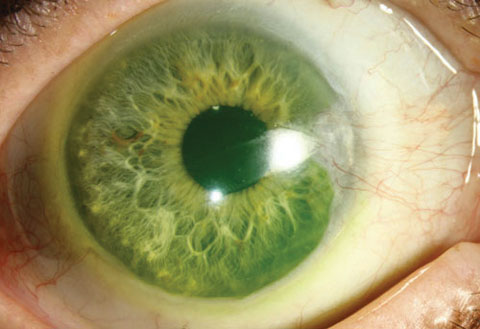 |
| Scleral lens thickness didn't seem to have an effect on corneal edema risk in this study. Photo: Christine Sindt, OD. Click image to enlarge. |
There is a potential threshold for material oxygen permeability (∼>100Dk) and central lens thickness (∼<600μm), beyond which further changes in these parameters have minimal influence on corneal edema under open-eye conditions. Researchers recently determined that, with a 141Dk scleral lens, the magnitude of corneal edema only reached a statistically significant difference for the 150µm and 1,200μm thickness comparison (on average 0.99% more edema for the thicker lens). Because most modern scleral lenses (manufactured with materials with ≥100Dk) have a center lens thickness of ≤600μm (excluding cases of high hyperopia or aphakia), modifications to reduce the lens thickness from 600μm to a value as thin as 150μm would be of limited clinical benefit in reducing corneal edema during open-eye lens wear.
The study recruited nine participants (mean age: 30 years old) with normal corneas who wore scleral lenses with oxygen permeability of 141Dk, back vertex power of -1.00D, total diameter of 16.5mm and back optic zone radius of 7.46mm. The participants wore the lenses under open-eye conditions on separate days with nominal center thicknesses of 150µm, 300µm, 600µm and 1,200μm. Epithelial, stromal and total corneal edema were measured using high-resolution OCT immediately after lens application and after 90 minutes of wear, before lens removal. The lens thickness profile across the central 12.5mm of each lens was measured using an OCT imaging technique with customized software.
The mean error total corneal edema was 1.14, 1.36, 1.74 and 2.13 for the 150µm, 300µm, 600µm and 1,200μm lenses, respectively. The magnitude of corneal edema was similar for the 150µm, 300µm and 600μm thickness lenses. The researchers noted that theoretical models overestimated the effect of increasing scleral lens thickness upon central corneal edema for higher lens thickness values (lens Dk/t<20) when controlling for initial central fluid reservoir thickness.
“It is apparent that alterations to the fluid reservoir thickness (using an estimated Dk of 80 for the fluid reservoir) have a greater influence on corneal edema than altering the lens thickness of a highly oxygen permeable material,” the authors wrote in their paper.
They also suggested scleral lens practitioners could modify the fit of the landing zone in clinical practice to allow some ingress of oxygenated tears into the fluid reservoir. However, while this could potentially increase oxygen transmission and reduce corneal hypoxia, it may also result in fluid reservoir debris.
The study noted that the corneal edema data from this experiment (in terms of the absolute magnitude of edema) can only be applied to young healthy eyes. In these eyes, the corneal swelling response is less variable compared with eyes with reduced endothelial cell count.
Fisher D, Collins M, Vincent S. Scleral lens thickness and corneal edema under open eye conditions. Eye Contact Lens. March 24, 2022. [Epub ahead of print]. |

